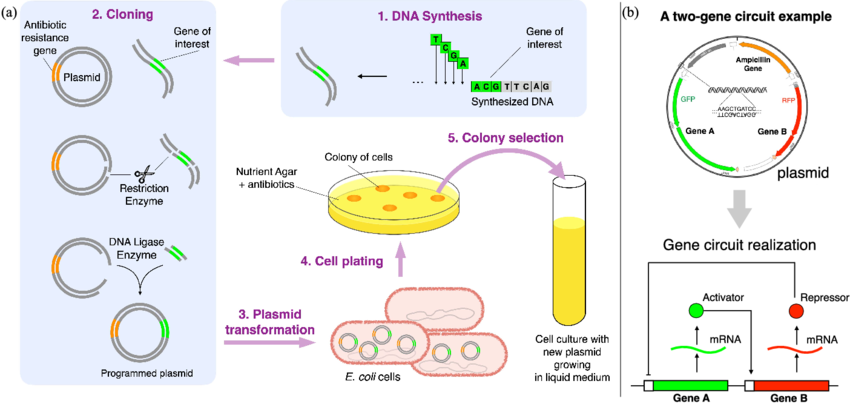The Role of Enzymes in Modern Biotechnology
Introduction
Enzymes, the biological catalysts that drive countless reactions within living organisms, play a pivotal role in modern biotechnology. These proteins speed up chemical reactions without being consumed in the process, making them indispensable tools in research and industrial applications. Understanding how enzymes function and their applications can provide insight into their critical role in advancing biotechnology.
Enzyme Basics
Enzymes are proteins that facilitate biochemical reactions by lowering the activation energy required for the reaction to proceed. Each enzyme is specific to a particular substrate, fitting together like a lock and key. This specificity allows enzymes to catalyze reactions with high precision and efficiency.
Enzymes are classified based on the reactions they catalyze:
- Hydrolases: Catalyze hydrolysis reactions, breaking down molecules with the addition of water (e.g., proteases, lipases).
- Oxidoreductases: Catalyze oxidation-reduction reactions (e.g., dehydrogenases, oxidases).
- Transferases: Transfer functional groups from one molecule to another (e.g., kinases, transaminases).
- Lyases: Catalyze the addition or removal of groups to form double bonds (e.g., decarboxylases).
- Isomerases: Catalyze the rearrangement of atoms within a molecule (e.g., racemases, epimerases).
- Ligases: Catalyze the joining of two molecules with the input of ATP (e.g., DNA ligase).
Applications of Enzymes in Biotechnology
Genetic Engineering
Genetic engineering (read-more) relies heavily on enzymes to manipulate DNA. Restriction enzymes, also known as molecular scissors, cut DNA at specific sequences, enabling the removal or insertion of genetic material. DNA ligases then join these fragments, creating recombinant DNA molecules that can be introduced into host organisms.
Polymerase chain reaction (PCR) is another cornerstone technique that amplifies specific DNA sequences. Taq polymerase, a thermostable enzyme, synthesizes new DNA strands by extending primers during thermal cycling, facilitating the detection and analysis of genetic material.
Protein Engineering
Enzymes are not only tools but also targets of biotechnology. Protein engineering involves modifying enzyme structures to enhance their properties, such as stability, activity, or specificity. Directed evolution mimics natural selection in the laboratory, creating libraries of enzyme variants and screening for improved functions. This approach has led to the development of enzymes with novel capabilities for industrial and therapeutic applications.

Industrial Biotechnology
Enzymes are used in various industrial processes to improve efficiency and sustainability. In the biofuel industry, cellulases and hemicellulases break down plant biomass into fermentable sugars for ethanol production. Amylases and proteases are essential in the food industry, aiding in the production of bread, beer, and dairy products by modifying starches and proteins.
The textile industry employs enzymes for fabric processing and finishing. For instance, cellulases are used in bio-polishing to remove excess fibers and enhance fabric quality, while proteases are used in leather processing to remove hair and other impurities.
Medical Biotechnology
Enzymes play a crucial role in medical diagnostics and therapeutics. Enzyme-linked immunosorbent assays (ELISAs) use enzyme-antibody conjugates to detect the presence of specific antigens or antibodies in biological samples, aiding in the diagnosis of infectious diseases, cancers, and other conditions.
Therapeutically, enzymes are used to treat various diseases. For example, enzyme replacement therapy provides patients with specific enzyme deficiencies with the functional enzyme, alleviating symptoms and improving quality of life. Additionally, enzymes like DNase and asparaginase are used in the treatment of cystic fibrosis and leukemia, respectively.
Laboratory Reagents and Enzymes
While discussing the role of enzymes, it's essential to recognize the importance of high-quality laboratory reagents. These reagents, including buffers, substrates, and cofactors, are vital for maintaining enzyme activity and stability during experiments. For instance, DNA polymerase requires magnesium ions as a cofactor for optimal function, and the accuracy of PCR depends on the purity of the reagents used.
Moreover, advances in enzyme technology have led to the development of more robust reagents that enhance the efficiency and reliability of biotechnological processes. For example, the use of thermostable enzymes in PCR not only improves the reaction's specificity but also allows for higher yields of amplified DNA, essential for downstream applications like cloning and sequencing.
| 0337- X2555-10 | Cleanascite™ Lipid Removal Reagent and Clarification, 10 ml |
| 0001-EC-890-1L | ProtoGel (30%) - 1 liter |
| 0001-HS-200 | [HS-200] Histoclear I - 1 US Gallon (3,7L) |
| 0001-HS-202 | [HS-202] HistoClear II - 1 US Gallon - 3,7 L |
Enzymes are at the heart of modern biotechnology, driving innovations across various fields from genetic engineering to industrial processes and medical applications. Their ability to catalyze reactions with high specificity and efficiency makes them indispensable tools in research and industry. As biotechnology continues to evolve, the development and application of enzymes will undoubtedly play a crucial role in shaping the future of science and technology.
Recent Posts
-
Can mNGS Replace Culture?
In microbiology and infectious-disease work, culture has been the gold standard for over a century. …30th Sep 2025 -
Post-Translational Modifications: The Hidden Layers of Protein Regulation
Proteins are the workhorses of cellular biology, performing a wide array of functions that are essen …18th Oct 2024 -
Unveiling the Structure-Function Relationship in Proteins: Why Shape Matters
Proteins are fundamental biomolecules that drive virtually every biological process within an organi …18th Oct 2024



